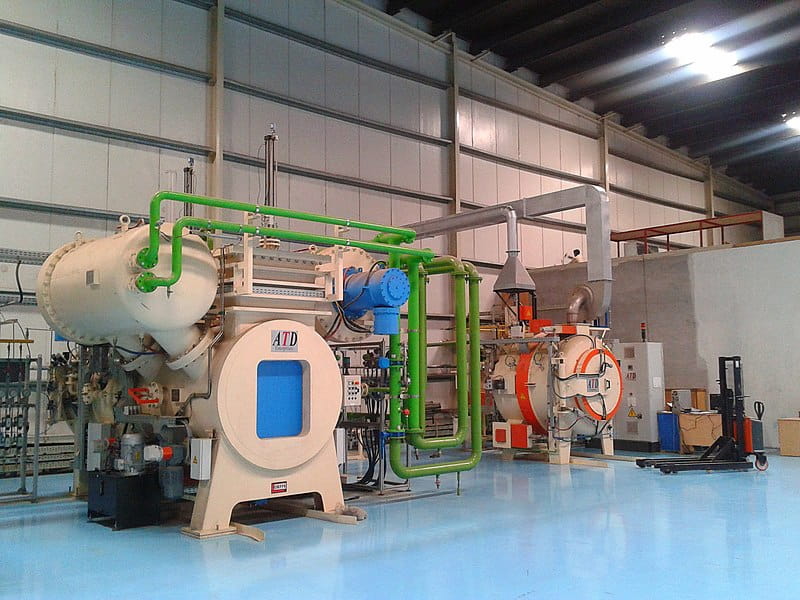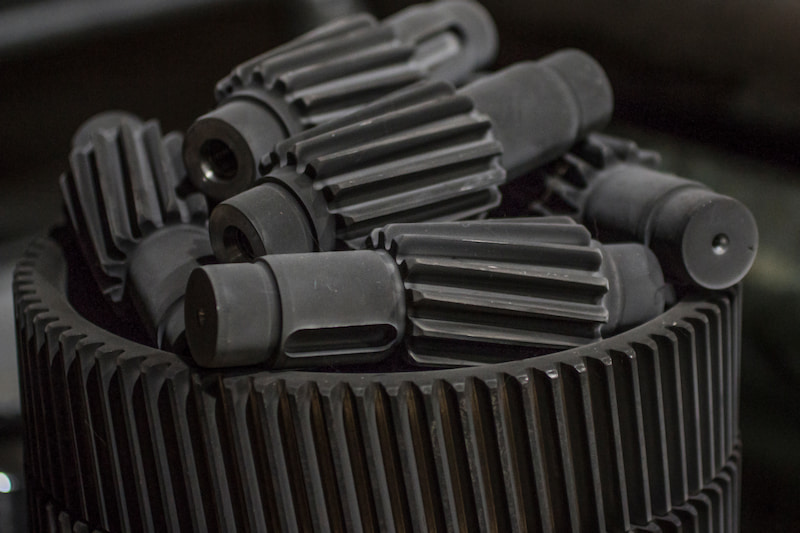Many types of heat treatment methods are used across the industry to make metals more suitable for different applications.
In this article, we explore a thermochemical surface treatment process that hardens a metal’s outer surface by increasing its nitrogen concentration.
What Is Nitriding?
Nitriding is a type of case-hardening process that hardens the outer layer of a part by adding nitrogen to its surface. The added nitrogen combines with iron and other alloying elements in the metal’s composition to form hard metallic nitrides.
As the nitrogen reaches only a certain depth, the interior of the part retains its original properties and, therefore, is relatively softer. We can achieve a final surface hardness of up to 76 HRC (90 HRA) through the nitriding process.
The hardness layer (case depth) generally has a thickness of 200–300 𝜇m (0.0002m) but can be up to 2 mm in some applications. We can control it by changing factors such as the duration of exposure, nitriding temperature, gas flow, etc.
The nitriding process creates a compound layer – a white layer as the outer layer with a diffusion zone underneath. The diffusion zone consists of the absorbed nitrogen as well as the hard nitride precipitates.
Nitriding is carried out at temperatures below the austenitisation temperature of steel. The austenite formation begins at 727 °C (1340 °F) for plain carbon steel but varies for alloy steels based on composition.
Thus, nitriding is typically carried out at a process temperature between 500 and 550 °C (930 – 1022 °F) and up to maximum temperatures of 620 °C (1150 °F).
The nitriding process can take anywhere from 4 to 100 hours. Beyond 100 hours, the layer thickness increases at a very slow rate, making the process unfeasible.
When Is Nitriding Used?
Nitriding is not used on all types of steel. It can be used for plain carbon steel, but it is generally preferred for low-carbon alloy steels that have nitride-forming elements such as aluminium, molybdenum and chromium. These elements facilitate precipitation hardening.
Apart from steels, nitriding also provides good results with titanium, molybdenum and aluminium alloys.
Nitriding Benefits
Nitriding provides many advantages over popular case hardening procedures such as carburising. Some of the benefits of using nitriding are as follows.
Lower temperature
The nitriding process works at temperatures of about 550 °C (1022 °F), which is well below the temperatures of other processes such as carburising. Nitrided parts, therefore, undergo reduced distortion and deformation and offer very good dimensional control.
High surface hardness with a ductile core
Nitrided parts have high surface hardness coupled with a ductile core. The combination of these properties provides a wear-resistant surface with a flexible core that can handle impact loads much better than a hard material.
Thus, we can use nitrided components in applications where impact loads are present along with exposure to abrasives or friction without worrying about sudden failure under high loads.
Increased corrosion resistance
The nitriding process improves the corrosion resistance of some steels. The deposited hard nitride layer prevents the formation of pits that would eventually corrode through pitting corrosion in an untreated part. To obtain maximum corrosion resistance, the white layer formed after the nitriding process must be maintained intact.
Plasma nitriding, for instance, improves the corrosion resistance of 410 stainless steel as the iron nitride layer on the surface protects the metal underneath from a corrosion attack.
But there are cases where nitriding increases the corrosion rate. For instance, when plasma nitriding was performed on martensitic X17CrNi16-2 stainless steel, its corrosion resistance actually decreased. This is mainly because of the formation of chromium nitride which reduces the initial corrosion protection offered by chromium in the solid solution.
- Personal account manager
- Quality assurance
- Payment terms for companies
- On-time delivery by Fractory
Anti-galling properties
Nitriding can also impart anti-galling properties to parts. Galling refers to adhesive wear between metals due to sliding contact. The nitriding process increases a part’s resistance to galling.
Improved fatigue life
The fatigue life of steel parts saw an upward tick as nitriding showed an improved fatigue strength in the range of 30 to 100 percent in different applications.
More resistant to softening at higher temperatures
The case hardening layer can start to lose its hardness at higher temperatures. This is commonly observed with processes such as carburising. The rate of softening is, however, considerably lower for nitriding.
Thus, nitrided parts can be used in high-temperature applications without a considerable loss in surface hardness.
Nitriding Processes
The nitriding process is the diffusion of nitrogen into the surface layer of alloy steel at high temperatures. There are three main ways of doing this. These are:
-
Gas nitriding
-
Salt bath nitriding
-
Plasma nitriding
Let’s take a quick look at each type and understand how they differ from each other.
Gas Nitriding

In gas nitriding, the heated metal part is exposed to anhydrous ammonia gas in a furnace. As the temperature increases, the ammonia decomposes into nitrogen and hydrogen. The nitrogen gets diffused into the surface, forming an exceptionally hard nitride layer.
Depending on the application, gas nitriding may be a single or two-stage process. Modern equipment today allows us to precisely control the gas nitriding process. We can use this process for mass production applications as the batch size is only limited by the gas flow and the furnace size.
Gas nitriding is more economical than other methods, especially when compared to the plasma nitriding process. But it can take a long time – up to 80 hours for some applications. Manufacturers often use gas nitriding to strengthen gears against rolling contact fatigue failures.
Salt Bath Nitriding
In salt bath nitriding, the material is placed in a liquid bath that contains nitrogen-based salt. As the temperature increases, the nitrogen from the salt enters the surface of the part. The salt may also contain carbon at times, making the process a nitrocarburising process instead of a nitriding process.
Salt bath nitriding allows greater nitrogen diffusion into the part than gas nitriding for the same duration. It is a relatively simple process and is quicker than other methods.
Salt bath nitriding is a popular process in the manufacturing of crankshafts, gears, tools and dies.
Plasma Nitriding
Plasma nitriding, also known as ion nitriding, uses ionisation to deposit nitrogen into a metal part.
The pure nitrogen gas is ionised in the surrounding of the metal substrate by setting up strong electric fields. The nitrogen ions diffuse into the substrate’s surface and form hard metallic nitrides.
As the process depends on the ionisation of the nitrogen gas, it does not require very high temperatures. Process temperatures as low as 260 °C (500 °F) are good enough for plasma nitriding.
The plasma may thus be hot or cold. Cold plasma is generated using vacuum tubes.
Plasma nitriding is commonly used to harden austenitic stainless steel and is used for products such as medical/surgical instruments, automobile parts and construction materials.
Conclusion
Nitriding can be a very effective method to obtain high-hardness parts capable of replacing even tool steels in many applications.
Nitriding of stainless steels in particular has undergone the most development in the last 10 years. The research has improved the understanding and cost of the process while providing highly accurate control over it.
While nitriding is already extensively used in the industry, it is expected to increase further over the next decade.



